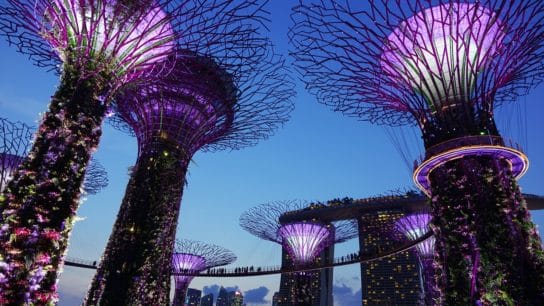This article delves into the concept of green construction, exploring its importance in minimizing environmental impacts, conserving resources, and preventing land degradation, all while meeting the demands of a rapidly evolving world.
—
In light of global net zero commitments, the construction sector is striving to become more environmentally friendly. Companies and individual builders have adopted eco-conscious processes and energy efficiency to ensure they promote sustainability in the long term. However, building without destroying the natural world is equally critical.
Green construction aims to minimize the industry’s impacts so the natural and built worlds can coexist harmoniously. It helps conserve precious resources and ecosystems, prevent pollution and increase cost savings. By embracing sustainable construction, the sector can meet demand without sacrificing the Earth for future generations. Here is an overview of land degradation in construction and strategies for building with minimal destruction.
Land Degradation and the Construction Industry
Traditional construction does not hold the best reputation for environmental protection. Soil erosion in heavy construction sites is 2 to 40,000 times higher than under natural conditions and it also negatively impacts water quality.
Overall, land loss is significant, degrading critical habitats, putting wildlife at risk and hindering agricultural prosperity. Fortunately, you and your team can help minimize these degrading effects by incorporating greener building practices into your construction workflow.
4 Ways to Build With Minimal Disruption
Green construction is more than sustainable building materials and design efficiency. While these factors are important, constructing with minimal adverse impacts on the planet is equally critical. Here are four ways eco-conscious construction evolves without destroying natural landscapes.
1. Redeveloping Land
Brownfield properties are former industrial sites, typically with hazardous contamination. They have been underused or abandoned due to industrial pollution. Although redeveloping brownfields is complex and requires several procedures for work and public safety, many have endeavored to clean them and build anew.
Over 450,000 brownfields across cities in the United States are ready for assessment and revitalization. Similar to what happens when you build on greenfield sites – undeveloped land that can be used for residential or commercial development – this approach to eco-conscious construction prevents further habitat fragmentation.
Redeveloping brownfields can boost the economy and create new employment opportunities for city residents. Addressing pollution also aids public health by improving air quality and drinking water resources. In some instances, construction companies can reuse existing infrastructure on brownfield sites, cutting costs significantly.
2. Utilizing Vacant Properties
Infill development uses vacant lots and unused land parcels within existing infrastructure for new construction. This helps preserve surrounding cities’ habitats and farmland. Reinforcing existing buildings, roads, and utilities saves money and protects ecosystems from further degradation.
The infill approach to construction often creates a denser built environment with excellent transportation services. Residents can then take public trains and buses, bike, or walk more easily. There is also a chance to increase property values in these areas.
3. Working With the Natural Landscape
Architectural experts have found creative ways to construct around nature. In Mallorca, Spain, the O67 House was built into a hill with stunning views of the Mediterranean Sea by Osvaldo Luppi Architects. The famous designer Frank Lloyd Wright has also constructed many homes in nature, including his Pennsylvania dwelling over a waterfall in Bear Run.
Residential construction is one of many opportunities to integrate the built and natural environments. Roadways and bridges can also be erected with minimal environmental impacts. However, adequate retainment structures and drainage systems are required to avoid erosion.
Relocating drainage mechanisms away from retaining walls is the best way to avoid using extra materials and modified processes. Experts recommend a 15-degree angle to reinforce the soil and hold everything in place.
You might also like: Greening Urban Development: The Business Case for Investing in Urban Green Spaces
4. Safeguarding Trees
Trees are essential to mitigating the adverse effects of global warming. Forests sequester about 30% of carbon dioxide from fossil fuel emissions. Construction impacts tree stability and soil compaction, damaging roots, limbs and trunks.
To protect mature trees, a more sensitive approach to construction is necessary. For example, a site assessment helps contractors determine which trees must be protected, while a comprehensive plan should prevent compaction and breakage.
Using smaller equipment and soil-boring machinery is also recommended for trees you intend to conserve. That way, everyone on the project knows exactly where to avoid disturbing the trees.
Eco-Conscious Construction Is the Future
Tomorrow’s infrastructure will no longer follow traditional construction standards. Tying the built environment into natural landscapes is important to save the Earth. Consider leaning into these methods if home, commercial or city infrastructure projects are on your radar. Doing so will benefit the living environment.
How can I contribute to a more sustainable planet?
- 🗳️ Vote for Climate Action: Exercise your democratic rights by supporting candidates and policies that prioritize climate change mitigation and environmental protection. Stay informed with Earth.Org’s election coverage.
- 👣 Reduce Your Carbon Footprint: Make conscious choices to reduce your carbon footprint. Opt for renewable energy sources, conserve energy at home, use public transportation or carpool, and embrace sustainable practices like recycling and composting.
- 💰 Support Environmental Organizations: Join forces with organizations like Earth.Org and its NGO partners, dedicated to educating the public on environmental issues and solutions, supporting conservation efforts, holding those responsible accountable, and advocating for effective environmental solutions. Your support can amplify their efforts and drive positive change.
- 🌱 Embrace Sustainable Habits: Make sustainable choices in your everyday life. Reduce single-use plastics, choose eco-friendly products, prioritize a plant-based diet and reduce meat consumption, and opt for sustainable fashion and transportation. Small changes can have a big impact.
- 💬 Be Vocal, Engage and Educate Others: Spread awareness about the climate crisis and the importance of environmental stewardship. Engage in conversations, share information, and inspire others to take action. Together, we can create a global movement for a sustainable future.
- 🪧 Stand with Climate Activists: Show your support for activists on the frontlines of climate action. Attend peaceful protests, rallies, and marches, or join online campaigns to raise awareness and demand policy changes. By amplifying their voices, you contribute to building a stronger movement for climate justice and a sustainable future.
For more actionable steps, visit our ‘What Can I do?‘ page.
This story is funded by readers like you
Our non-profit newsroom provides climate coverage free of charge and advertising. Your one-off or monthly donations play a crucial role in supporting our operations, expanding our reach, and maintaining our editorial independence.
About EO | Mission Statement | Impact & Reach | Write for us














